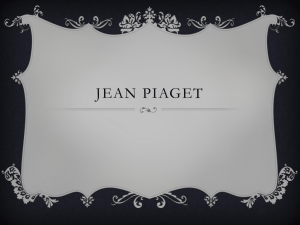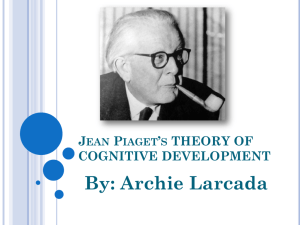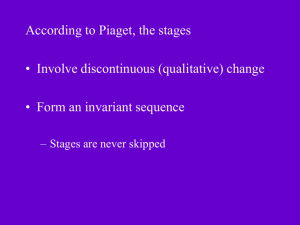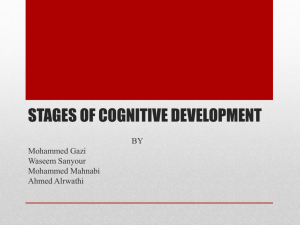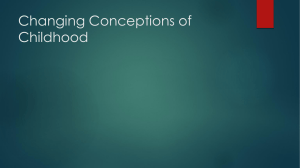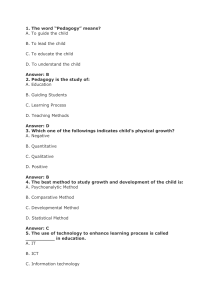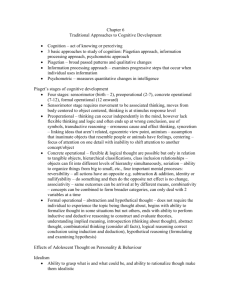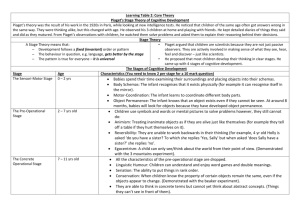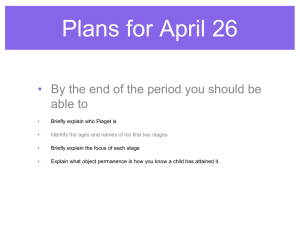Piaget*s Theory of Cognitive Development
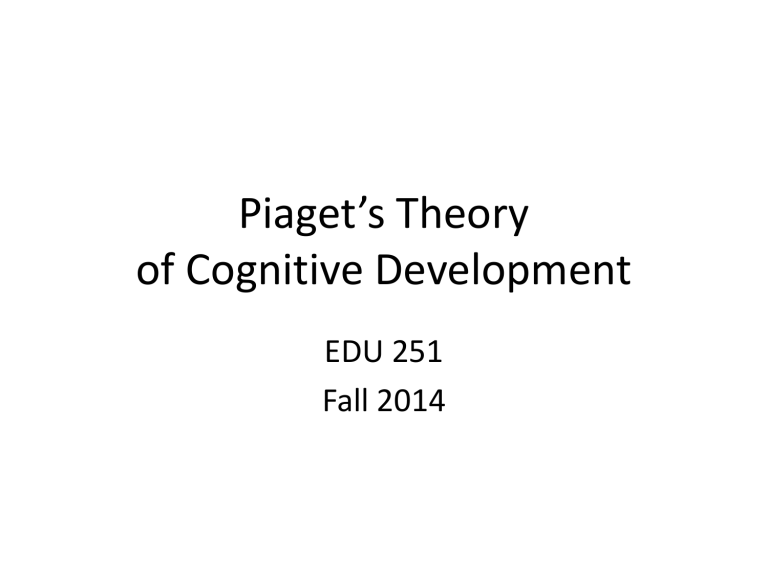
Piaget’s Theory of Cognitive Development
EDU 251
Fall 2014
The Beginning
• Piaget was interested in the study of knowledge in children.
• He administered Binet’s IQ test in Paris and observed that children’s answers were qualitatively different.
• Piaget’s theory is based on the idea that the developing child builds cognitive structures
(schemes used to understand and respond to physical environment).
Piaget’s Theory of
Cognitive Development
• Cognition: How people think & Understand.
• Piaget developed four stages to his theory of cognitive development:
– Sensorimotor Stage
– Pre-Operational Stage
– Concrete Operational Stage
– Formal Operational Stage.
SENSORIMOTOR
STAGE
PREOPERATIONAL
STAGE
CONCRETE
OPERATIONAL
STAGE
FORMAL
OPERATIONAL
STAGE
The infant constructs an understanding of the world by coordinating sensory experiences with physical actions.
And infant progresses from reflexive, instinctual action at birth to the beginning of symbolic thought toward the end of the stage
The child begins to represent the world with words and images.
These words and images reflect increased symbolic thinking and go beyond the connection of sensory information and physical action.
He child can now reason logically about concrete events and classify objects into different sets
The adolescent reasons in more abstract, idealistic, and logical ways.
Birth to 2 Years of Age 2 to 7 Years of Age 7 to 11 Years of Age
11 Years of Ages
Through Adulthood
4
The Sensorimotor Stage
• From birth to approximately 2 years
• The child relies on touching, feeling and using his senses to find out about the world
• Begins with reflexive responding and ends with using symbols
• Object permanence
5
Object Permanence
• The differentiation in the sensorimotor stage that objects and other people continue to exist outside the infant’s perception.
• Forerunner of perceptual constancy
The Preoperational Stage
• From approximately 2 to 7 years
• Two substages
– Preconceptual (2-4 years)
– Intuituve (4-7 years)
• Children use symbols but are many errors in thinking
> Egocentrism: The inability to distinguish between one’s own perspective and someone else’s perspective.
> Centration: Focusing on one characteristic to the exclusion of others
> Confuse appearance and reality (lack Conservation)
7
Conservation
• The ability to understand that quantities of objects continue to have the same amount of length, substance, number, etc. if only the form has changed.
The Concrete Operational Stage
• From approximately 7 to 11 years
• Thinking based on mental operations (strategies and rules that make thinking more systematic and powerful)
• Operations can be reversed
• Focus on the real and concrete, not the abstract
9
The Formal Operational Stage
• From approximately 11 years to adulthood
• Adolescents can think hypothetically
• Use deductive reasoning
10
According to Piaget, there are four interrelated factors which together help a child move from one stage to the next:
Operations
• Actions carried out mentally
• Conservation
• Reversibility
– The realization that any change of position, shape, order, etc. can be reversed, i.e. returned to its original shape, position or order.
Three Types of Knowledge
Equilibrium
• Assimilation
• Accommodation
Other Terms from Glossary
• Animism
• Cognitive Conflict
• Disequilibrium
• Overdifferentiation
• Overgeneralization
• Play (assimilation)
